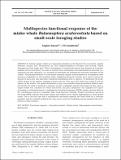Files in this item
Multispecies functional response of the minke whale Balaenoptera acutorostrata based on small-scale foraging studies
Item metadata
| dc.contributor.author | Smout, Sophie Caroline | |
| dc.contributor.author | Lindstrom, Ulf | |
| dc.date.accessioned | 2013-02-08T15:01:05Z | |
| dc.date.available | 2013-02-08T15:01:05Z | |
| dc.date.issued | 2007-07 | |
| dc.identifier | 397643 | |
| dc.identifier | fa440d9e-3e95-429b-8edd-1fec62981b4a | |
| dc.identifier | 000248392300024 | |
| dc.identifier | 34547603630 | |
| dc.identifier.citation | Smout , S C & Lindstrom , U 2007 , ' Multispecies functional response of the minke whale Balaenoptera acutorostrata based on small-scale foraging studies ' , Marine Ecology Progress Series , vol. 341 , pp. 277-291 . https://doi.org/10.3354/meps341277 | en |
| dc.identifier.issn | 0171-8630 | |
| dc.identifier.uri | https://hdl.handle.net/10023/3345 | |
| dc.description.abstract | Atlantic minke whales are important predators in the Barents Sea ecosystem; capelin Mallotus villosus, krill Thysanoessa sp. and Meganyctephanes norvegica and herring Clupea harengus are their major prey. Their consumption of commercial species may present an economic problem for the local fishery. In order to estimate this consumption and understand the potential consequences for prey dynamics, it is essential to determine the multispecies functional response of the whales. The parameterisation of a functional response requires measurements of consumption rates and prey availability. In this localised study, undigested stomach contents were used to assess the amount of each prey that had been consumed immediately prior to capture. To determine the availability of prey to the whales, standard acoustic surveys were run in the same area within 2 d of the capture of the whales. The spatial distribution of prey was modelled using generalised additive models (GAMs). In order to generate a measure of prey availability and the uncertainty in this value, a simple model was assumed for whale movement, and prey abundance was sampled over space according to a Gaussian kernel. A multispecies functional response (MSFR) model was then fitted to the consumption and prey availability data using Bayesian methods. Simple simulations, based on the fitted MSFR, indicate that minke whales may deplete local capelin aggregations at small spatial scales. This is the first time that a multispecies functional response has been fitted for a cetacean predator, and the methods outlined here may prove useful for modelling marine mammal-fish interactions in other systems. | |
| dc.format.extent | 15 | |
| dc.format.extent | 683676 | |
| dc.language.iso | eng | |
| dc.relation.ispartof | Marine Ecology Progress Series | en |
| dc.subject | Functional response | en |
| dc.subject | Generalist predator | en |
| dc.subject | Minke whale | en |
| dc.subject | Baleonoptera acutorostrata | en |
| dc.subject | Barents Sea | en |
| dc.subject | Northeast Atlantic | en |
| dc.subject | Ecosystem | en |
| dc.subject | Coexistence | en |
| dc.subject | Management | en |
| dc.subject | Abundance | en |
| dc.subject | Fisheries | en |
| dc.subject | Prey | en |
| dc.subject | Food | en |
| dc.subject | Determinants | en |
| dc.subject | QL Zoology | en |
| dc.subject | SDG 14 - Life Below Water | en |
| dc.subject.lcc | QL | en |
| dc.title | Multispecies functional response of the minke whale Balaenoptera acutorostrata based on small-scale foraging studies | en |
| dc.type | Journal article | en |
| dc.contributor.institution | University of St Andrews. School of Mathematics and Statistics | en |
| dc.contributor.institution | University of St Andrews. Scottish Oceans Institute | en |
| dc.contributor.institution | University of St Andrews. Sea Mammal Research Unit | en |
| dc.identifier.doi | 10.3354/meps341277 | |
| dc.description.status | Peer reviewed | en |
| dc.identifier.url | http://www.scopus.com/inward/record.url?scp=34547603630&partnerID=8YFLogxK | en |
This item appears in the following Collection(s)
Items in the St Andrews Research Repository are protected by copyright, with all rights reserved, unless otherwise indicated.

